It started with a Tweet. Something cropped up on Twitter that led me a merry dance through the sub-species of medieval headgear. By the end, I felt I knew how many angels’ bonnets could fit on the head of a pin.
Five years ago, my very first post was on ‘Norfolk’s Stained Glass Angels’. In it I showed one of this county’s most beautiful glass paintings of an angel in a feather suit completed by a feather hat [1].
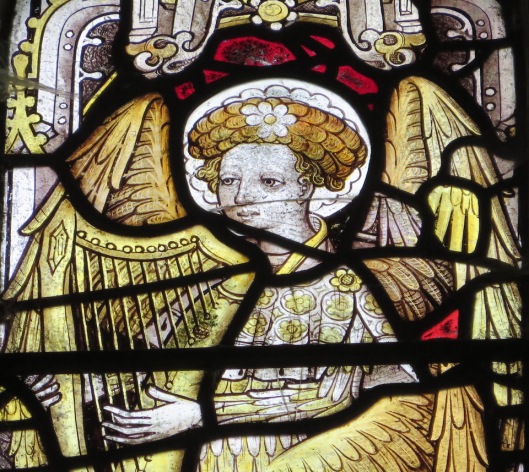
Harp-playing angel wearing a feather suit. All Saints, East Barsham, Norfolk. Painted by the workshop of John Wighton from c1450.
When I want to know about a Norfolk church my first port of call is Simon Knott’s site for the descriptions of the astonishing 912 churches he has visited in Norfolk [2]. In May, Simon posted a Tweet on this C15 angel from Feering in Essex.

Simon Knott’s Tweet
The feather hat I’d seen in East Barsham and other Norfolk churches was virtually identical to one that Simon had seen in Essex so I asked him via Twitter if feather bonnets were East Anglian, rather than an exclusively Norfolk thing.

C15 painted angel from All Saints, Feering, Essex. Photo credit: Simon Knott
In my first blog post [1], I found that it was possible to overlay the East Barsham head on top of other Norfolk C15 painted-glass angels. The exactness of the match suggested they were copied from the same template, meaning they were from the same workshop. One stylistic tic uniting glass from various Norfolk churches with the figures drawn in the great east window of Norwich’s St Peter Mancroft (the benchmark for Norfolk painted glass) was the double flap covering the entrance to the ear. I hope regular readers will forgive me banging on but this lug flap is known as the tragus. A double tragus is a developmental rarity, yet both the ‘Essex’ and the Norfolk angels share this distinguishing feature. Simon Knott pointed out that the glass in All Saints, Feering, Essex was a loose collection of English and Continental 15th to 18th century pieces brought together by Father Bundock, who died in 1989 [3]. So, the ‘Essex’ angel may well have been recycled from a Norfolk church and was almost certainly painted in Norwich.
David King, the authority on Norwich School glass, detected the ‘hand’ of at least three artists responsible for painting the east window of St Peter Mancroft, Norwich [4]. The glass was made in the mid C15 in the Norwich workshop of Alderman John Wighton, who was succeeded by John Moundford of Utrecht (assisted by his wife), followed in turn by Moundford’s son John.

A C15 angel from John Wighton’s Norwich workshop. From the east window, St Peter Mancroft, Norwich
But I digress. What I was really interested in here was the Feering angel’s feather bonnet. Sally Badham, former President of the Church Monuments Society, suggested via Twitter (@SallyBadham), that the headgear was an orle of the kind she had seen on glass and monuments in Yorkshire. I had to look this up. One definition of an orle is a border set in from the edge of a shield, giving a clue to the heraldic origin of the name.

However, there is an alternative definition of orle that gets us closer to the angel’s bonnet. Wiktionary gives it as: ‘the wreath, or chaplet, surmounting or encircling the helmet of a knight and bearing the crest; a torse’. ‘Torse‘ is an obsolete French word for wreath and appears to be synonymous with ‘orle‘.

Knight with an eagle crest at the Saracen Joust in Arezzo, Tuscany. Wikipedia CC BY-SA 3.0 Cavalieredicasata, to which I added the arrow pointing to the torse. The knight’s squire also wears one for decoration while the knight himself probably wears one inside the helmet for comfort.
In heraldic terms, the torse – introduced in the late C14 – is described as the cloth circlet intended to hide the join between the ornate tournament crest and the helmet [5]. The colours in the coil were the same as the wearer’s livery colours except, it seems, when the knight wore a lady’s favour. Such a makeshift torse could be a handkerchief, a ribbon or even the lady’s sleeve, twisted into a rope and worn around the helmet.
This twisted rope – the torse or orle – also applied to something that the knight originally wore in combat. For comfort, he would have worn a padded, circular orle beneath the heavy helm to lift it away from the head and eyes. With the development of lined, padded helmets the orle became redundant but was retained for decorative purposes. Below, on the effigy of Sir Richard Vernon, a highly decorative orle is worn outside the helmet [6]. The sculptor has carefully depicted the roll of fabric studded with beads or even jewels and pearls. So, by this stage, not a utilitarian thing.

The effigy of Sir Richard Vernon, St Bartholomew’s Church, Tong, Shropshire (d.1451) Wikipedia. CC-BY-SA/2.0. Photo credit: Sjwells53
Below, the two celestial beings appear to be wearing stuffed orles around their heads, in which case the material billowing out of the hollow doughnut could be a caul or crespine – a bag-like net of gold, silver or silk thread.

In the tracery of SS Peter & Paul, East Harling, Norfolk

The Virgin Annunciate in the tracery of Stratton Strawless, St Margaret. The doughnut-shaped headdress of this female saint is decorated with bosses.
Another item – the chaperon – plays a key part in the development of medieval headgear. This gets quite technical but, basically, the chaperon seems to have evolved out of Marty Feldman’s hood from the film, Young Frankenstein.

Marty Feldman as Igor in Mel Brooks’s ‘Young Frankenstein’. He wears a hooded cape with a long tail – the cornette or liripipe – at the back. It ends in a pom-pom glimpsed beneath his left hand.
By wearing the face-opening of the caped hood around the top of the head – not the face – and tying it up with the long tail, the cape evolved into a hat that was worn throughout Europe in the Middle Ages.
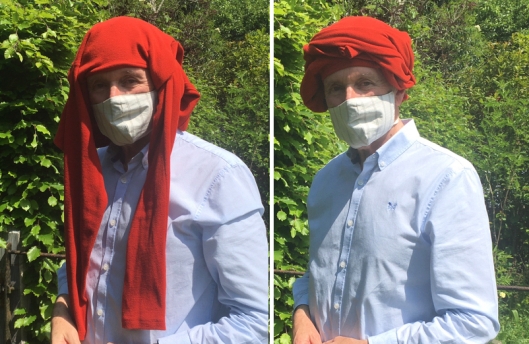
Place the face-opening of your wife’s sweater over your head then wrap the loose arms around your head (or, in the case of a medieval hood, the long cornette hanging at the back).
The chaperon became ‘the most commonly worn piece of male headgear in Early Netherlandish painting’ [7]. And it is this form, with the long hood tied up on top, away from messy paint, that is being modelled in this probable self-portrait by Jan van Eyck (d. 1441). Sometimes titled, ‘Man in a Red Turban’ it should really be called ‘Man in a Red Chaperon (tied up with its Cornette or Liripipe)’.
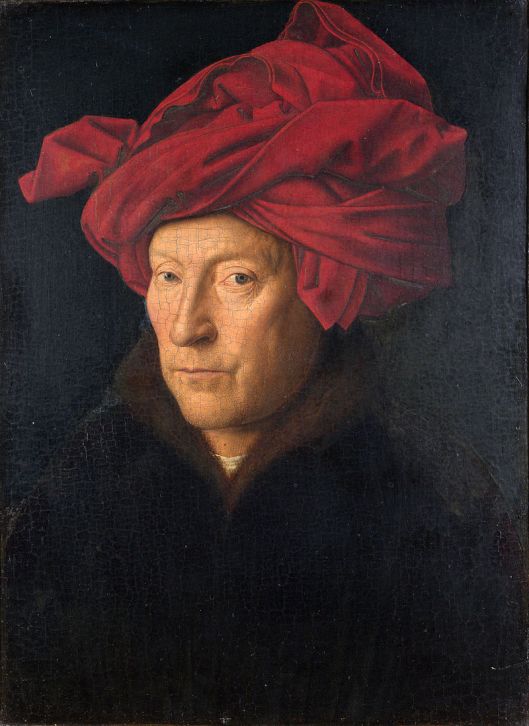
Probably a self-portrait by Jan van Eyck 1433. National Gallery, London. Known to have been in the collection of the 1st Earl of Norfolk ,’The Collector Earl’ (1585-1646), when he was exiled in Antwerp.
Van Eyck was one of the first (Vasari said the first) artists to paint with oil, using thin translucent oil glazes to build up luminous flesh. In this, the painters of the Northern Renaissance were ahead of the Italians. Based in Bruges, the Italian Giovanni Arnolfini spent most of his life in Flanders; van Eyck painted his portrait wearing another complicated headpiece of red woollen fabric, this time the flaps are down and the loosely-twisted roll is clearly visible.

Portrait of Giovanni di Nicolao Arnolfini by Jan van Eyck c.1435. Gemäldgalerie, Berlin
The earliest of van Eyck’s portraits to survive shows a man in the same three-quarter profile pose. Here, the chaperon appears to have developed into a more formal version, pulled over the head like a mob cap or Scotch bonnet, instead of something wound around the crown.

Portrait of a Man with Blue Chaperon by Jan van Eyck c1430. Brukenthal National Museum
These examples of men’s headwear suggest how fashions from heraldic dress worked themselves into everyday life. They also transferred to female fashion: a C14 chronicler (quoted in [8]) described how ladies riding to a tournament would affect a masculine appearance by wearing short hoods that were wrapped about their heads by the liripipe.
Again on Twitter, Sally Badham suggested that the angel’s headpiece could also be based on the bourrelet. Like chaperons, bourrelets appear to have originated by rolling up a hood around the head but by the mid-C15 they had developed into a more formal, doughnut-shaped padded roll [7]. Now, however, the doughnut-shaped bourrelet had undergone a further transformation into a ring of fabric folded around a framework, possibly made of wire [9].
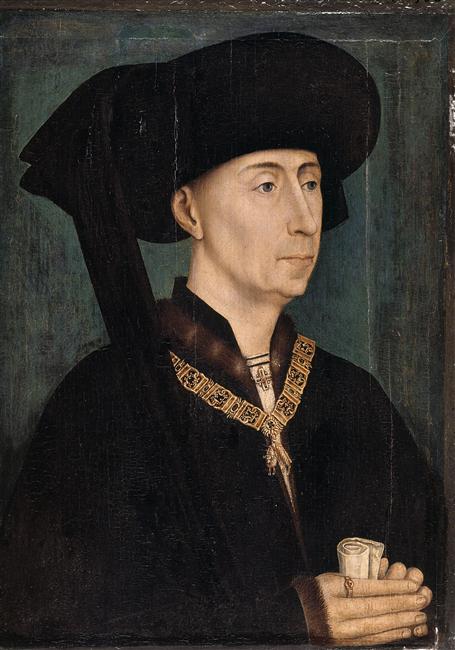
The very large bourrelet of Philip the Good, Duke of Burgundy c1450. After Rogier van der Weyden

The doughnut-shaped bourrelets of ‘The Tax Collectors’, late 1520s by Quentin Massys. The Collections of the Prince of Liechenstein, Vaduz-Vienna
Planché [8] suggests that the turban-like headgear worn by European men and women in the mid C15 evolved out of the chaperon – the hooded cape, twisted into fanciful shapes. On the other hand, both the stuffed or hollow bourrelet and the twisted torse have been likened to the turban that crusaders had seen in the Middle East. Separate influences or convergent evolution?
The bride in the Marriage Feast at Cana, from SS Peter & Paul East Harling, was said by Norwich-glass expert Christopher Woodforde to be wearing a good example of a ‘turban head-dress decorated with a large jewelled ornament’ [10].

C15 Norwich School glass by the Wighton workshop. SS Peter & Paul East Harling, Norfolk.
Clues to the kind of headwear fashionable in mid-to-late C15 Norfolk can also be found in this county’s outstanding painted rood-screens. For instance, St Cecilia is illustrated (below) wearing a wreath of lilies to symbolise her virginity (the purity of which has been sullied by political emblems: the red rose of Lancaster and the white rose of York – two houses united by Henry Tudor in 1485). The copy of the floral wreath she holds in her hand reveals it to be made of two twisted strands. This perhaps tells us more about wreath-making than contemporary fashion but I’ll show this fine portrait of sorrowful Cissy anyway, since it is so different from the usual stereotypes.

St Cecilia with her wreath of virginity, from St Mary’s North Elmham, Norfolk.
The remarkable series of screen paintings in St Michael and All Angels at Barton Turf, painted in the late C15 [11], illustrates three Saints and nine Orders of Angels. This figure is a protective Principality from the Third Order of Angels. Ignoring the gold crown, this appears to be a twisted bourrelet or turban encircling a conical cap.

One of the Principalities (First Order of Third Hierarchy), incidentally holding a flask of urine. St Michael and All Angels, Barton Turf, Norfolk
Again from Barton Turf, Archangel Michael in late C15 armour (below) wears a hat that encircles the head. This floral headwear, seen against the background of the halo, could be a hollow bourrelet studded with foliage.
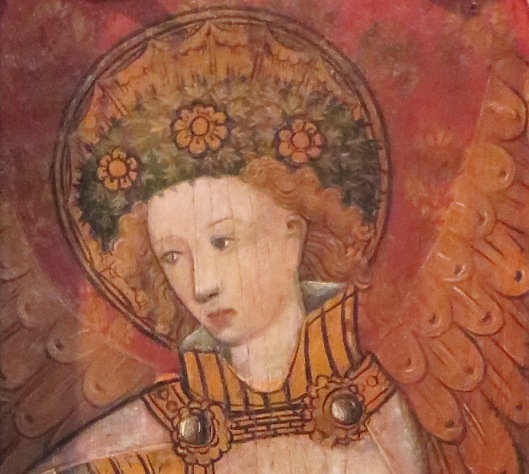
Archangel (Second Order, Third Hierarchy) in late C15 plate armour. St Michael and All Angels, Barton Turf, Norfolk.
The Cherubim below, from the Second Order of the First Sphere of Angels, wears a crown encircled by a red, doughnut-shaped wreath – the dabs of white suggestive of feathers.

A Cherubim with two pairs of wings, its omniscience symbolised by the all-seeing eyes on the wing feathers; the cap seems to be covered with smaller contour feathers. St Michael and All Angels, Barton Turf, Norfolk
The leader of the Powers, Archangel Raphael, is seen below thrashing the devil. His headgear is comprised of a helmet encircled with overlapping feathers decorated with a central badge.

Archangel Raphael, usually depicted in armour. St Michael and All Angels, Barton Turf, Norfolk
Similar feather hats are depicted on painted glass.

From St Mary’s, Burnham Deepdale, Norfolk
An angel in the tracery of the east window at SS Peter & Paul, East Harling also wears a feather bonnet. If made at the same time as the superb main panels then this glass was painted around 1480 by John Wighton’s successors in his Norwich workshop. Angels were often depicted wearing feather onesies that ended neatly at neck, cuff and ankles, reflecting the outfits worn by actors in medieval mystery plays [12]. In this case, the angel’s feather hat could simply be the natural accompaniment to these outfits. However, there is evidence that by the late fifteenth- early sixteenth century, caps and bonnets were also in great vogue in secular life, ‘ornamented with a profusion of feathers‘[8].
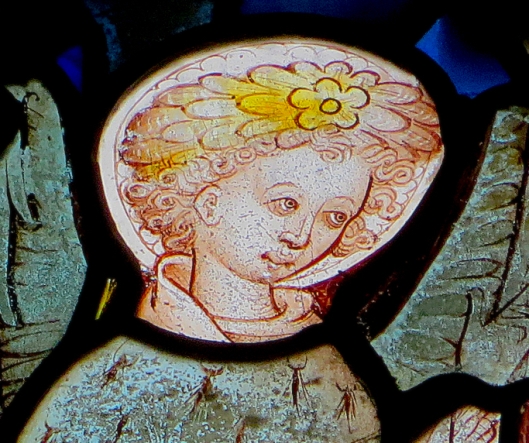
From Saints Peter and Paul, East Harling, Norfolk
Postscript
After posting this article, photographer Paul Harley (whose site contains superb images of Norfolk angels https://paulharley.wordpress.com/category/angels/ ) sent me this photograph of a harp-playing angel from Weston Longville.

From All Saints, Weston Longville, Norfolk. ©Paul Harley
It is a beautiful painting. Not only does the angel wear a very similar bonnet to the one worn by the East Barsham angel, but the overall pose is identical – the angels sharing many details, including that double tragus in the ear.

Left: East Barsham; right: Weston Longville (©Paul Harley)
Paul also sent images of two ‘Powers’ from the Order of Angels, set in the tracery of the east window at Salle. Note the decorative orles worn around their helmets.

The Powers hold chains and bundles of birch to vanquish evil, around their heads are suns representing the heavens. ©Paul Harley
©2020 Reggie Unthank
Thanks: I am grateful to fellow Tweeps: Simon Knott (@last_of_england) and Sally Badham (@SallyBadham), for their readiness to help and for starting me out on this trail, and to Sue Roe (@SueRoeGardener) for the mugshots. Thanks, too, to Paul Harley for sending photos from his collection of Norfolk Angels.
Sources
- https://colonelunthanksnorwich.com/2015/12/19/norfolks-stained-glass-angels/
- http://www.simonknott.co.uk/
- http://www.simonknott.co.uk/essexchurches/feering.htm
- King, D. J. (2006) The Stained Glass of St Peter Mancroft, Norwich, CVMA (GB), V, Oxford.
- Arthur Charles Fox-Davies (1909). A Complete Guide to Heraldry. A project Gutenberg e-book (2012). https://www.gutenberg.org/files/41617/41617-h/41617-h.htm#page402
- https://en.wikipedia.org/wiki/Chaperon_(headgear)
- Paul F Walker (2013). The History of Armour 1100-1700. Pub: The Crowood Press Ltd.
- James Robinson Planché (1876). An Illustrated Dictionary of Historic Costume: from the First century BC to c1760. Reprinted by Dover Publications Inc in 2003.
- https://www.virtue.to/articles/women_roll_hats.html
- Christopher Woodforde (1950). The Norwich School of Glass-Painting in the Fifteenth Century. Pub: Oxford University Press.
- Nikolaus Pevsner and Bill Wilson (1997). The Buildings of England. Norfolk I: Norwich and the North-East. Pub: Yale University Press.
- https://colonelunthanksnorwich.com/2016/08/18/angels-in-tights/
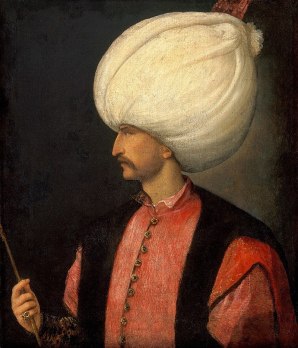
Suleiman the Magnificent by Titian c1530

Fascinating and interesting research. The long scarf/turban is still used by the people of the Sahara when they are in the desert, keeping their hair free of dust and covering their mouths in windy conditions. I’d only thought of the Barton Turf screen for angelic headgear, in fact I’d not given angelic headgear much of a thought until I read this!
LikeLike
Hi Paul, I’d never thought of angelic headgear, either, until trying to find if Simon Knott’s ‘Essex’ glass could have come from Norfolk. I agree that most of the ‘cape around the head’-type headwear all seem to have been anticipated by the Touareg.
LikeLiked by 1 person
There’s a fine head dressed harpist in the stained glass at Weston Longville too with an almost identical head dress to East Barsham but a different face (I can send a copy if you like but I don’t think I can attach it to this). Also full credit to Simon Knott for his comprehensiveness and the quality of his writing.
LikeLike
I would like to see that Weston Longville glass please Paul. And, yes, there’s much to admire in Simon Knott’s pieces.
LikeLike
Great stuff as usual-and I’ve been loving Simon Knott’s site for over a decade now!
LikeLike
I stand in awe of Simon Knott’s energy. His site is a must for East Anglian church-spotters (and for expats, too)
LikeLike
What a delight! Inspiration too for creative facial coverings in our own times?? Thank you!
LikeLike
I vaguely remember, as a young boy, wrapping my jumper around my head on a hot day. Not too different from the face masks we wore to a garden centre this morning.
LikeLike
Hello, thanks for this fascination piece. One query (sorry!): at Barton Turf, is the Leader of the Powers Gabriel (as it says above), or Raphael (as it says in the caption)? I’m guessing Gabriel …
LikeLike
Thanks for spotting the deliberate mistake (hem, hem). Archangel Raphael is the leader of the Powers and this has been modified in the post.
LikeLike
Reggie,
What a great piece, having a lug flap myself, I am pleased to read that I share this distinguishing feature with angels!
LikeLike
Having seen photographic proof of the double tragus/ear flap thingy from Mrs Kleiweg I can confirm you are one of the heavenly host (as painted in fifteenth century Norwich).
LikeLike
A hoodie on a coat or jacket is called a ‘capuchon’ in Dutch.
‘capu’ from ‘caput’ in Latin?
I much enjoyed remembering Marty Feldman with that super photo!
Thank you for this fine blog, Reggie.
P.S.: These days I bring my ‘corona-hair’ in some sort of shape with
twisted turban-like scarves…
LikeLike
Fascinating how different-sounding languages have common roots. ‘Capuchon’sounds so much like ‘capuchin’, which was applied to the Capuchin monks on account of their gowns with long pointed hoods (cappuchio).Cappucchino coffee is in there somewhere.
LikeLike
love your posts
LikeLike
Thank you Michele. I love your Norwich page on Pinterest.
LikeLike
Thanks for this: great pictures. It looks like the torse/capuchon is how they manage to incorporate the characteristic jewel of each of the Nine Orders, instead of making it a cloak clasp as in York and Malvern. (The Principality at Barton Turf has the cloak clasp.) This is fine until you are a Power and don’t have a cloak over your armour.
I think if you look at the OED, the use of ‘orle’ to mean a turban is a 19th-century misunderstanding. Original meaning is a ‘hem’. The twist of cloth is always a ‘torse’ – something twisted. Except when they decide to call it a turban, but somehow come up with a ‘turbot’ instead – found it in an early 16h-century manuscript and fell about, but it seems to be quite serious.
LikeLike
Thank you for these informative comments, Meg. I am fascinated to learn that each of the Nine Orders of Angels wore a characteristic jewel set in a brooch or ouche. The golden brooches in the headdress of the Norfolk angels would be consistent with this. However, the brooches themselves can be painted in a generic – often perfunctory – daisy-like fashion that appears to make little distinction between the orders. Might this be due to the inability of silver nitrate (with a limited range from straw to amber) to represent the colours of various jewels? I’d be grateful for references on this topic?
LikeLike
Wonderful! Research takes us down some very unexpected byways. And thanks for reminding me of ‘The Young Frankenstein’, a film I loved back then. Must try to watch it again.
LikeLike
Thank you Anne. One of my favourite films and I still chuckle at remembered lines.
LikeLiked by 1 person
So that’s what the donuts on figures in Norwich glass are about. Once again you have enlightened and brightened my day.
Don Watson
LikeLike
Yes, I’d always wondered about the donuts. Reading about all the paraphernalia that knights had to put on for battle was fascinating. Once unhorsed, with all that heavy armour and visibility reduced to a slit, it must have been like thrashing at a piñata.
LikeLike
I enjoyed this post so much, Reggie! Thank you for the gorgeous images and all the fascinating information. I always enjoy visiting Paul Harley’s blog and Simon Knott’s site has been a source of inspiration for some time. I love the mug shots!
LikeLike
I, too, am a great admirer of Paul Harley and the indefatigable Simon Knott. And I’m pleased you liked the post – it was fun to do.
LikeLiked by 1 person
Pingback: Sculptured Monuments | COLONEL UNTHANK'S NORWICH
Good to see this type of research with excellent photos. The head described as from Paston, St Margaret, is actually from a figure of the Virgin Annunciate at Stratton Strawless, St Margaret.
LikeLike
My mistake, now corrected. Thank you for the kind comments, much appreciated from someone who has done more than anyone to record the stained glass of Norfolk churches.
LikeLike
Pingback: Norfolk Rood Screens | COLONEL UNTHANK'S NORWICH